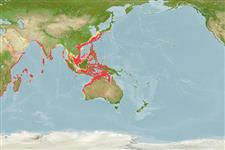Teleostei (teleosts) >
Eupercaria/misc (Various families in series Eupercaria) >
Latilidae (Deepwater tilefishes)
Etymology: Branchiostegus: Greek, brangchia = gills + Greek, stego = roof, to cover (Ref. 45335).
Environment: milieu / climate zone / depth range / distribution range
Ecology
Marine; demersal; depth range 45 - 180 m (Ref. 9607). Deep-water
Indo-West Pacific: Red Sea and off Durban, South Africa. Reported from the Arafura Sea (Ref. 9819), northwestern Australia (Ref. 5978) and the Philippines (Ref. 9877, 9880).
Size / Weight / Age
Maturity: Lm ? range ? - ? cm
Max length : 60.0 cm TL male/unsexed; (Ref. 5591)
Occurs in the continental shelf (Ref. 7300). Found over muddy bottoms (Ref. 5213). Considered poisonous by local fishers in the Red Sea and thus are generally discarded (Ref. 9880).
Life cycle and mating behavior
Maturities | Reproduction | Spawnings | Egg(s) | Fecundities | Larvae
Amirthalingam, C., 1969. A new fish from the Red Sea. Sudan Notes Rec. 50:129-133. (Ref. 9874)
IUCN Red List Status (Ref. 130435)
Threat to humans
Poisonous to eat (Ref. 9880)
Human uses
Tools
Special reports
Download XML
Internet sources
Estimates based on models
Preferred temperature (Ref.
123201): 20.5 - 27.8, mean 25.3 °C (based on 265 cells).
Phylogenetic diversity index (Ref.
82804): PD
50 = 0.5000 [Uniqueness, from 0.5 = low to 2.0 = high].
Bayesian length-weight: a=0.00708 (0.00294 - 0.01707), b=3.07 (2.86 - 3.28), in cm total length, based on LWR estimates for this (Sub)family-body shape (Ref.
93245).
Trophic level (Ref.
69278): 3.6 ±0.5 se; based on size and trophs of closest relatives
Resilience (Ref.
120179): Medium, minimum population doubling time 1.4 - 4.4 years (Preliminary K or Fecundity.).
Fishing Vulnerability (Ref.
59153): Moderate vulnerability (44 of 100).
